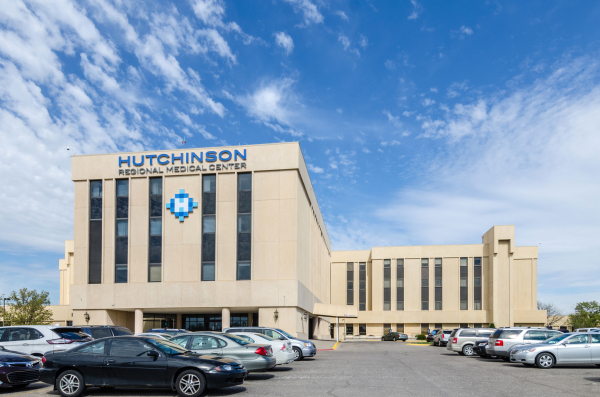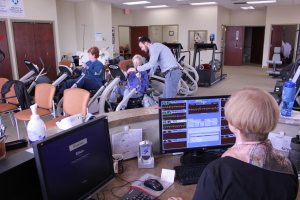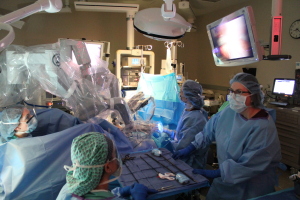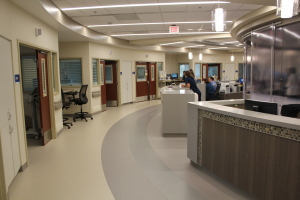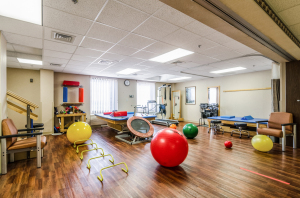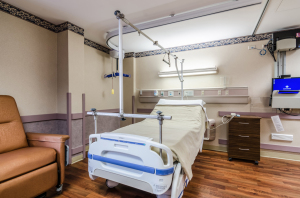Building success on culture and community
March 20, 2020
by Sean Ruck, Contributing Editor
Wesley Hoyt, COO for Hutchinson Regional Healthcare System transitioned from a military career into the private sector in 2016 and he didn’t miss a beat. HealthCare Business News spoke with him to learn more.
HCBN: What inspired you to follow a career in healthcare?
WH: It wasn’t a traditional inspiration. I was a soldier in the Army and when my enlistment was up I went back to school to get my commission as an Army officer. The year I graduated, there was a need for medical service corps officers. The Army selected me and put me into the healthcare field.
That was back in 1990. It wasn’t something I can say I anticipated, but based on my enlistment and experience, I was able to take that new opportunity and really grow with it. I had a great career in the Army. I learned a lot and was exposed to a lot of new experiences and leader development as a medical officer. Ultimately, they helped me go to grad school at Baylor University where I earned a master’s in Healthcare Administration (Go Bears!) and through progressive assignments, gave me a portfolio of experience, education and professional development that led me to where I am now.
HCBN: You became COO for Hutchinson in 2016 — is that when you joined the organization too?
WH: It is. I retired from the army in August of 2016 directly into Hutchinson Regional Healthcare System in my current role.
HCBN: What drew you to Hutchinson?
WH: As I prepared to transition from the United States Army and retire, I looked far and wide for an opportunity to continue to be a healthcare executive. I applied for many jobs, got a lot of interviews, visited quite a few places, but it was an on-site interview at Hutchinson where my wife and I were able to visit together, after we attended the American College of Healthcare Executives annual congress in Chicago. What drew me here was the opportunity. What sold me was the way it felt, from the time I came to the facility and met the CEO, and got to see the building and meet the people. It had all the components I was looking for in my transition.
It was an organization I could come to and contribute. I could take all the skills I developed and use them for good in a facility that was this size and still supporting the community. I didn’t want to be part of a mega system. I wanted to be part of the community, be on boards, volunteer, have neighbors I could get to know, and come to work every day and get a sense of fulfillment.
HCBN: What makes Hutchinson Regional Medical Center stand out?
WH: Culture — what you see is what you get. Our mission drives our culture, which means we support our community. That is why we exist. Our values are something we not only promote and display, but we hold ourselves accountable and coach each other to be better every day and apply our values in all aspects — not just at work, but at home and in the community.
We’re the largest employer in our community. There’s a commitment when you have that, but it’s also a very strong obligation to do the right thing. We do that, we understand that, and we take it seriously. Our health affects the community health.
HCBN: Can you talk about some of the challenges Hutchinson faces?
WH: I wish I could say our challenges are unique to what everyone else is facing, but there are so many challenges. We’re not a major metropolitan area, but we’re within 50 to 60 miles of one. We’re challenged with recruitment of medical professionals because in a rural community like we are, the government considers us rural, but also within close proximity to a metropolitan statistical area. So you have the challenge of leakage, recruiting, people going back and forth each way for a few cents more of pay.
We also have the challenge of access that we constantly struggle with, because if you don’t have the right medical professionals and people can’t get in, that subsequently feeds what you do in a medical center. There’s also market share and competing for medical resources. And we are struggling every day like every other facility with an ever-changing payor mix and reimbursement structure. Every year, the government is changing some rule or regulation that has a ripple effect on healthcare organizations as we work to remain compliant. My payor mix is roughly 60% Medicare, 20% commercial, 10 to 12% Medicaid and then 8 to 12% self-pay, depending on time of year. If 60% of my payor mix is based on government payor, you strive to remain solvent based on that, but you really can’t do it because of all the rules and regulations that come with accepting that money.
My biggest expenses are going to be my personnel costs, labor and benefits. After that, it’s maintaining the buildings and utilities. When I get past that, it’s all the consumables with the single greatest consumable expense being pharmacy. When you think about an unregulated area where you can name your price, that really hits your bottom line, because not every payor or insurer reimburses you the same. You have to hire people just to negotiate the system, which is direct overhead.
HCB News: On the pharmaceutical side, there seems to be some bipartisan support for importing prescriptions from Canada, for example, to reduce costs. Is that something you’re watching with interest?
WH: We are, absolutely. How much of what we’re restricted with is due to lack of market dynamics? Is there appropriate competition to keep prices down? The other piece I would challenge someone to show me in having lived abroad for my last six years in the Army, both in German and Italy, where there’s a socialized healthcare system, what they would pay is not nearly what we would pay for those drugs. So somewhere there’s an inequity on who is really bearing the cost for research and development. It makes you wonder if it’s a level playing field. I don’t think it is, but how can you challenge it when those are multibillion-dollar industries?
HCBN: You mentioned challenges regarding attracting talent. Are you experiencing shortages of any particular type of healthcare professional for your organization?
WH: We are. Hutchinson is in Reno County. Geographically, if I’m not mistaken, we’re the second largest county in the state of Kansas. But we’re also the second oldest. That makes it challenging when you start dealing with the demographic of elderly patients and all their conditions and comorbidities when they present for care. We’re in a community that we try to recruit physicians in, but there’s the lure of living 55 miles away in Wichita and driving here. We want it to be enticing for them to live in the community where they can become good community members and stewards of our resources. Because every one of them is a highly-paid professional, which means if they’re not living here, you’re paying them, but that money is going somewhere else. Even more than that, if you can recruit to your area, can you recruit the right specialties? We struggle with making sure we have enough primary care physicians. We need neurologists, gastroenterologists, OB-GYN, and there’s a whole host of other specialties. We need to get them here, show they’re valued, and make sure we prevent burnout.
HCB News: Do you work with any local schools to introduce students to a healthcare career?
WH: We do. Starting with the secondary education level, we partner with all the public and private high schools and offer a program every summer that’s eight to 10 weeks long. We bring in 10 to 15 students that go through an application process and rotate them through almost every department in the hospital. Basically, it’s a healthcare internship program. We have a great success rate for them going on and pursuing nursing careers and other healthcare service careers, it’s a good introduction to healthcare.
We also partner with the local community colleges and universities as a residency site for their nursing, respiratory therapist, OT/PT, and speech therapy programs. We help with instructors, but also open our organization for them to come in and do their actual live didactic and hands-on portion.
HCBN: Are there any recent notable expansions or improvements?
WH: There are. When I arrived three and a half years ago, I was fortunate to come into a facility that was well-built in the early 70s, had great infrastructure, but was aging. We spent the last three-and-a-half years slowly reinventing ourselves — repairing things that needed repairing, overhauling a lot of the infrastructure, but also examining what service lines we really wanted to be in. Recently, we reopened our orthopedic ward after overhauling our service line. We completely embraced the enhanced recovery after surgery protocols, purchased a new orthopedic Mako robot which not only helps the surgeons be more precise, but also reduces the length of stay. We renovated our ward and now it’s a state-of-the-art orthopedic center that has caught the attention of local community colleges who partner with us to be their orthopedic center of excellence.
HCB News: How do you anticipate healthcare will change over the next five to 10 years?
WH: I don’t see the costs going down. As a result, I see the financial pressures causing us to be very innovative in where we deliver healthcare. We’re so fixated on the brick and mortar because that’s where people see their comfort. In many ways, it’s a safety net for people. Yet, as it gets more complicated and more expensive, I think we’ll see healthcare pushed into the home. So I see an evolution in the number of actual beds that we need in brick and mortar facilities, through the use of telemedicine and the instant access to diagnostic results and images. Hospitals are becoming more virtualized. This is especially true in addressing the healthcare needs of patients in other rural and frontier communities. Our focus will continue to be to provide access to high-quality, patient-centered healthcare that is reasonably priced.
HCBN: What inspired you to follow a career in healthcare?
WH: It wasn’t a traditional inspiration. I was a soldier in the Army and when my enlistment was up I went back to school to get my commission as an Army officer. The year I graduated, there was a need for medical service corps officers. The Army selected me and put me into the healthcare field.
That was back in 1990. It wasn’t something I can say I anticipated, but based on my enlistment and experience, I was able to take that new opportunity and really grow with it. I had a great career in the Army. I learned a lot and was exposed to a lot of new experiences and leader development as a medical officer. Ultimately, they helped me go to grad school at Baylor University where I earned a master’s in Healthcare Administration (Go Bears!) and through progressive assignments, gave me a portfolio of experience, education and professional development that led me to where I am now.
HCBN: You became COO for Hutchinson in 2016 — is that when you joined the organization too?
WH: It is. I retired from the army in August of 2016 directly into Hutchinson Regional Healthcare System in my current role.
HCBN: What drew you to Hutchinson?
WH: As I prepared to transition from the United States Army and retire, I looked far and wide for an opportunity to continue to be a healthcare executive. I applied for many jobs, got a lot of interviews, visited quite a few places, but it was an on-site interview at Hutchinson where my wife and I were able to visit together, after we attended the American College of Healthcare Executives annual congress in Chicago. What drew me here was the opportunity. What sold me was the way it felt, from the time I came to the facility and met the CEO, and got to see the building and meet the people. It had all the components I was looking for in my transition.
It was an organization I could come to and contribute. I could take all the skills I developed and use them for good in a facility that was this size and still supporting the community. I didn’t want to be part of a mega system. I wanted to be part of the community, be on boards, volunteer, have neighbors I could get to know, and come to work every day and get a sense of fulfillment.
HCBN: What makes Hutchinson Regional Medical Center stand out?
WH: Culture — what you see is what you get. Our mission drives our culture, which means we support our community. That is why we exist. Our values are something we not only promote and display, but we hold ourselves accountable and coach each other to be better every day and apply our values in all aspects — not just at work, but at home and in the community.
We’re the largest employer in our community. There’s a commitment when you have that, but it’s also a very strong obligation to do the right thing. We do that, we understand that, and we take it seriously. Our health affects the community health.
HCBN: Can you talk about some of the challenges Hutchinson faces?
WH: I wish I could say our challenges are unique to what everyone else is facing, but there are so many challenges. We’re not a major metropolitan area, but we’re within 50 to 60 miles of one. We’re challenged with recruitment of medical professionals because in a rural community like we are, the government considers us rural, but also within close proximity to a metropolitan statistical area. So you have the challenge of leakage, recruiting, people going back and forth each way for a few cents more of pay.
We also have the challenge of access that we constantly struggle with, because if you don’t have the right medical professionals and people can’t get in, that subsequently feeds what you do in a medical center. There’s also market share and competing for medical resources. And we are struggling every day like every other facility with an ever-changing payor mix and reimbursement structure. Every year, the government is changing some rule or regulation that has a ripple effect on healthcare organizations as we work to remain compliant. My payor mix is roughly 60% Medicare, 20% commercial, 10 to 12% Medicaid and then 8 to 12% self-pay, depending on time of year. If 60% of my payor mix is based on government payor, you strive to remain solvent based on that, but you really can’t do it because of all the rules and regulations that come with accepting that money.
My biggest expenses are going to be my personnel costs, labor and benefits. After that, it’s maintaining the buildings and utilities. When I get past that, it’s all the consumables with the single greatest consumable expense being pharmacy. When you think about an unregulated area where you can name your price, that really hits your bottom line, because not every payor or insurer reimburses you the same. You have to hire people just to negotiate the system, which is direct overhead.
HCB News: On the pharmaceutical side, there seems to be some bipartisan support for importing prescriptions from Canada, for example, to reduce costs. Is that something you’re watching with interest?
WH: We are, absolutely. How much of what we’re restricted with is due to lack of market dynamics? Is there appropriate competition to keep prices down? The other piece I would challenge someone to show me in having lived abroad for my last six years in the Army, both in German and Italy, where there’s a socialized healthcare system, what they would pay is not nearly what we would pay for those drugs. So somewhere there’s an inequity on who is really bearing the cost for research and development. It makes you wonder if it’s a level playing field. I don’t think it is, but how can you challenge it when those are multibillion-dollar industries?
HCBN: You mentioned challenges regarding attracting talent. Are you experiencing shortages of any particular type of healthcare professional for your organization?
WH: We are. Hutchinson is in Reno County. Geographically, if I’m not mistaken, we’re the second largest county in the state of Kansas. But we’re also the second oldest. That makes it challenging when you start dealing with the demographic of elderly patients and all their conditions and comorbidities when they present for care. We’re in a community that we try to recruit physicians in, but there’s the lure of living 55 miles away in Wichita and driving here. We want it to be enticing for them to live in the community where they can become good community members and stewards of our resources. Because every one of them is a highly-paid professional, which means if they’re not living here, you’re paying them, but that money is going somewhere else. Even more than that, if you can recruit to your area, can you recruit the right specialties? We struggle with making sure we have enough primary care physicians. We need neurologists, gastroenterologists, OB-GYN, and there’s a whole host of other specialties. We need to get them here, show they’re valued, and make sure we prevent burnout.
HCB News: Do you work with any local schools to introduce students to a healthcare career?
WH: We do. Starting with the secondary education level, we partner with all the public and private high schools and offer a program every summer that’s eight to 10 weeks long. We bring in 10 to 15 students that go through an application process and rotate them through almost every department in the hospital. Basically, it’s a healthcare internship program. We have a great success rate for them going on and pursuing nursing careers and other healthcare service careers, it’s a good introduction to healthcare.
We also partner with the local community colleges and universities as a residency site for their nursing, respiratory therapist, OT/PT, and speech therapy programs. We help with instructors, but also open our organization for them to come in and do their actual live didactic and hands-on portion.
HCBN: Are there any recent notable expansions or improvements?
WH: There are. When I arrived three and a half years ago, I was fortunate to come into a facility that was well-built in the early 70s, had great infrastructure, but was aging. We spent the last three-and-a-half years slowly reinventing ourselves — repairing things that needed repairing, overhauling a lot of the infrastructure, but also examining what service lines we really wanted to be in. Recently, we reopened our orthopedic ward after overhauling our service line. We completely embraced the enhanced recovery after surgery protocols, purchased a new orthopedic Mako robot which not only helps the surgeons be more precise, but also reduces the length of stay. We renovated our ward and now it’s a state-of-the-art orthopedic center that has caught the attention of local community colleges who partner with us to be their orthopedic center of excellence.
HCB News: How do you anticipate healthcare will change over the next five to 10 years?
WH: I don’t see the costs going down. As a result, I see the financial pressures causing us to be very innovative in where we deliver healthcare. We’re so fixated on the brick and mortar because that’s where people see their comfort. In many ways, it’s a safety net for people. Yet, as it gets more complicated and more expensive, I think we’ll see healthcare pushed into the home. So I see an evolution in the number of actual beds that we need in brick and mortar facilities, through the use of telemedicine and the instant access to diagnostic results and images. Hospitals are becoming more virtualized. This is especially true in addressing the healthcare needs of patients in other rural and frontier communities. Our focus will continue to be to provide access to high-quality, patient-centered healthcare that is reasonably priced.

